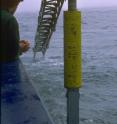RV Polarstern on its way to East Siberian Sea
Bremerhaven, August 19th 2008. German research vessel Polarstern, operated by the Alfred Wegener Institute for Polar and Marine Research in the Helmholtz Association, transits the Northwest Passage for the first time. Polarstern left the port of Reykjavik on August 12th, sailed around Greenland on a southern course and is located right in the Northwest Passage. Its destination is the East Siberian Sea where geoscientific measurements at the junction between the Mendeleev Ridge and the East Siberian Shelf are at the focus of the participants of this expedition. The measurements striven for in the framework of the International Polar Year shall help to understand how the undersea ridges and basins were built. This expedition takes the researchers in 68 days around the North Pole because the return voyage is to lead via the Northeast Passage. The researchers want to clarify the tectonic interrelations on the bottom of the Arctic Ocean in the track of Alfred Wegener, who founded the theory on continental drift in 1915. They employ seismic measurement methods which shall allow a glance at the geological units and sediments. "At the bottom of the sea we find mountains which are about the same height as the Alps," illustrates Chief Scientist Wilfried Jokat. "These are partially overlaid by sediments, so that we have to look beneath the surface to find clues hinting at the geological history of the Mendeleev Ridge," he explains further.
Where the Mendeleev Ridge meets the East Siberian Shelf, very old layers can be found at the surface of the sea bottom. If the researchers find such places by means of the equipment on board Polarstern, they will try to retrieve cores with a gravity corer. 50 million years old rocks crop out at these places; usually, only layers of the upper 10 to 15 metres can be cored with a gravity corer, which only shows layers about 1 million years old. Both sediment cores and sediment profiles shall be used to further a proposal for future Arctic depth drilling. Within the framework of the International Ocean Drilling Program (IODP), a long drilling core shall be gained which is anticipated by researchers worldwide. It will give new insights into Arctic geological history of the last 100 million years.
Furthermore, there are areas with a high rate of sedimentation in the East Siberian Sea. If the researchers manage to retrieve cores from these sediments, it will help to conclude climate history of the younger geological past. For example, the rate of organic carbon in sediment cores hints at biological activity, and researchers can reconstruct temperature and ice cover up to one million years ago.
Presently, organic carbon reaches the Arctic Ocean via rivers as well. For this reason oceanographers are interested in the East Siberian Sea. Similar to former cruise stages, they sample water and monitor temperature, salinity and depth. Additionally, they specify the concentration of terrestrial carbon in the water, by which they are able to calculate from which river the examined water originates and how long it has been on its way. These data shall help to understand climate relevant systems of currents in the Arctic Ocean.
Changes to marine currents also affect the biotic environment. This is why biologists investigate the species assemblage in samples of various regions and depths and compare them with measurements taken in the 1990ies. This way they can deduce, for instance, whether a changing ice cover affects the system's biological productivity. The copepod Oithona similes which lives both in the Arctic and Antarctic Ocean and also in the North Sea will be investigated in more detail. The researchers want to conduct experiments on board to see how they successfully reproduce in these different climatic zones.
All of this research is dependent on external factors like weather and, particularly, ice cover. Two months ago it was still uncertain whether Polarstern could transit the Northwest Passage; an alternative measurement program for Greenland Sea had been parked in the drawer. Current satellite pictures show that the Northwest Passage is almost ice free and that it can probably be sailed without big problems. During the expedition, cruise leader Jokat wants to get in contact with Canadian and US-American colleagues who undertake measurements in the Beaufort Sea. They can pass on information which no satellite can provide.
After its journey home through the Northeast Passage, Polarstern will reach Bremerhaven again on October 19th.
Source: Helmholtz Association of German Research Centres
Other sources
- RV Polarstern on its way to East Siberian Seafrom PhysorgThu, 21 Aug 2008, 15:36:36 UTC
